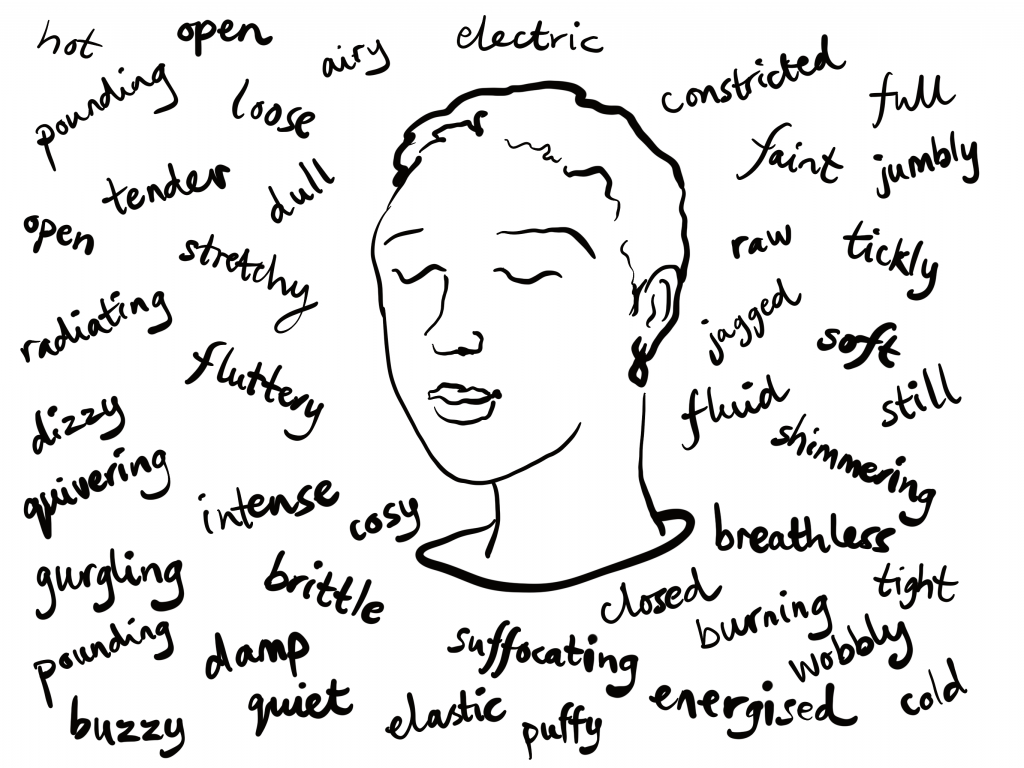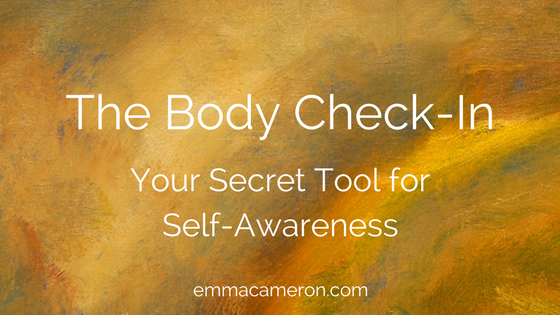Body Check-In: what is it, how do you do it, and why is it important?
A Body Check-In is simple to do, yet its impact can be quite profound. The Body Check-In is simply a way of tuning in to what’s going on inside you. It’s a secret tool for self-awareness, decision making and self-guidance.
Body Check-Ins can help you get clearer on what you want and need, and nudge you towards your best next step. It’s a kind of inner sat nav, to help you find your way through the maze of choices and disruptions in life.
Here’s what therapist Bari Tessler says about the Body Check-In:
It will bring you home to yourself. It will unravel layers and layers. It will soothe frayed nerves and dissolve the mental fog. *
Tessler recommends using the Body Check-In any time you have to make a financial decision (like whether or not to buy something) and also at all sorts of other moments when you want to connect to your inner guidance and feelings.
Body Check-In: Your Secret Tool for Self-Awareness Share on XA Body Check-In can help you:
- Know what you are feeling (“Am I hungry, angry, or tired? Or do I need comfort right now because I’m actually really sad?”)
- Remain centred when things start to feel overwhelming (So you don’t get swept away by fearful thoughts about the future, or drowned in feelings rooted in the past)
- Stay connected to your authentic self (Knowing your core emotions in the moment is a great way to feel authentic and true to yourself)
- Figure out how to connect to someone else when difficult stuff is coming up (Tuning in to what your body is saying you need, or what you fear, can help you work out how to connect even in a challenging situation)
- Make a decision (“Should I really buy those gorgeous leather boots?”)
- Allow yourself to stay with good feelings, even when this brings up anxiety (Because for many of us, feeling good can actually trigger foreboding thoughts of “Something bad must be just around the corner” so we unconsciously move away from good feelings too quickly)

The 7 steps of a Body Check-In
Some, like Tessler, call it a Body Check-In. Others prefer to use the term Body Scan. Dan Siegel likes to use the acronym SIFT: Scan your mind and body for Sensations, Images, Feelings and Thoughts.
Before we dive in to the how-to’s, here’s an important quick note: If you find you become very overwhelmed with difficult images, feelings or thoughts when you try doing a Body Check-In, it may be that some past trauma is coming up. Processing this with an experienced therapist may be necessary to help you move on.
1. Slow down and take a pause
Stop whatever you’ve been doing. If you’re with people, you may need to excuse yourself, and go to the bathroom or somewhere else that can provide a bit more peace and quiet.
2. Breathe
Turn your attention inward. Notice how you’re breathing.
Then take a few slower, deeper breaths. Make your out-breaths a bit longer, and gently blow out as if through a straw, long and slow. It might help to close your eyes.
3. Notice body sensations
Get curious and interested in what’s going on in your body. Don’t judge – this is NOT about assessing, approving or grading feelings. Just notice what’s going on without trying to change anything.
Skin: Can you feel moving air against your skin? Prickling? Heat or cold? Sensitivity? Or something else?
Stomach/ gut: Is there a sense of constriction? Openness? Expansion? Clenching? Quivering? Hardness? Or something else?
Chest/ lungs: Does your chest feel tight and held-in? Relaxed? Vulnerable? Limited? Or something else?
Throat: Does your throat feel blocked? Raw? Neutral? Delicate? Or something else?
Pelvic area: Do you feel quiet and stable? Numb? Aroused? Heavy? Aching? Full? Hungry for touch? Tight? Or something else?
Eyes, jaw and face: Is there tension? Relaxation? An urge to tighten, or loosen? Or something else?
Neck and shoulders: Are you armouring or bracing against something? Or do you feel loose and open? Or something else?
Arms and hands: Can you feel an impulse to hit out, or to pull in? Is there jitteriness or snapping? Or something else?
Legs and feet: Do they want to stamp? Jiggle? Do they feel wobbly or strong? Or something else?
The 7 steps for doing a Body Check-In Share on X4. Notice any emotions
Do you feel anxious? Irritated? Sad? Filled with awe? Furious? Tender? Excited? Or something else?
See if you can let yourself experience any feelings that are there. Notice if the emotions transform, build, or evaporate; or if they stay stuck and solid.
If this starts to feel a bit overwhelming, shift your attention to another part of your body that feels more neutral or steady. Perhaps you might consciously feel your feet, legs and ‘sitz’ bones and get a sense of their weight pushing into the chair and floor. (You may find that you can then turn your attention back to the difficult feeling for a short time, if you want to).
5. Make room for images
Often when someone does a Body Check-In, they realise that a felt image is emerging spontaneously.
Perhaps it’s a moment from a recent dream.
Or perhaps it’s a sense of bubbling. Or curling wisps of smoke. Or a big black block.
Sometimes the image could be something as concrete as a shiny metal bin, an exuberant cheerleader, a suit of armour, a snail hiding in its shell, or a snarling lioness.
These images can be sources of valuable information. Tune into the feeling of them; they may hold much wisdom.
6. Listen in to your thoughts
Almost as if there are two of you – one having thoughts, and the other one observing and listening without being ‘in’ the thoughts.
Maybe you’ll spot some self-critical thoughts. Or self-protective ones.
Perhaps you’ll notice your mother’s or father’s voice, warning or chiding you, or maybe saying something kind.
Perhaps you’ll spot a rebellious child: “Go on, buy it – forget the consequences!”
Maybe you can even get a little dialogue going, between one part of you and another. (No, this doesn’t mean you’re crazy! It can just help you get clearer about the different forces at play within you.)
Do keep an attitude of self-kindness through all this. Being annoyed at yourself, or trying to shut down thoughts or feelings, won’t ultimately be helpful. Try and make room for the thoughts and feelings instead. They’ll change when the time is right, once they’ve been dosed with enough kindly attention.
7. Invite any adjustments
As you deepen into awareness of your sensations, images, feelings and thoughts, you may notice some adjustments that would feel good.
Perhaps your jaw would like to loosen.
Your hands and arms might like to shake out.
Your feet may want to rock forwards and backwards.
You may want to smile, roll your neck and release some tension.
You might like to deepen your breath.
It’s all about awareness
You don’t have to change anything, or perfect anything. Although sometimes doing a Body Check-In will make us feel more calm, it won’t always – and that’s okay.
The immediate goal of the Body Check-In is simply to become more aware.
Although subtle, the Body Check-In is a tool that can become more powerful and effective the more you use it.
You can use a Body Check-In whenever you want to get clearer on something, or tune into yourself.
When someone asks you to do something, you can do a mini Body Check-In (or a full one) before you give them your answer.
(This is especially useful if you have a habit of agreeing to things and then feeling resentful later).
When you feel ‘off’, grumpy, snappy, bored or hopeless – do a Body Check-in!
(This may uncover the deeper issue underlying your surface feelings and behaviour).
Awareness can lead you to keeping appropriate boundaries, practising self-care, connecting authentically to others, and feeling more honest and more satisfied.
The awareness that the Body Check-In provides can help you use your emotions and bodily states as signposts that can guide you to make the best choices for your life.
And one last very important note: Be kind!
You won’t be able to benefit from a Body Check-In if you can’t be accepting and kind to yourself during and after the process.
If you notice yourself using ‘should’ (as in, “I shouldn’t be feeling that, I should be feeling [something else] instead”) please gently recalibrate and remind yourself that right now, you are okay just as you are – an imperfect, normal human being, who has flaws and quirks just as we all have.
It’s paradoxical but it’s a fact, that feelings and felt states can change more easily once they have been accepted and made room for.
Have fun! You’ll discover a whole lot more about yourself through doing Body Check-Ins.
If you are looking for someone to help you with the feelings and thoughts that come up through Body Check-Ins, or if you just want some support to help you through a time of transition in your life, you may wish to contact a therapist. I work with creative, sensitive, thoughtful women and HSP’s (Highly Sensitive Persons) using Integrative Arts Psychotherapy and counselling near Colchester, Essex, and I also offer online counselling.
*Quote from Bari Tessler, ‘The Art of Money: A Life-Changing Guide to Financial Happiness’, Parallax Press 2016



